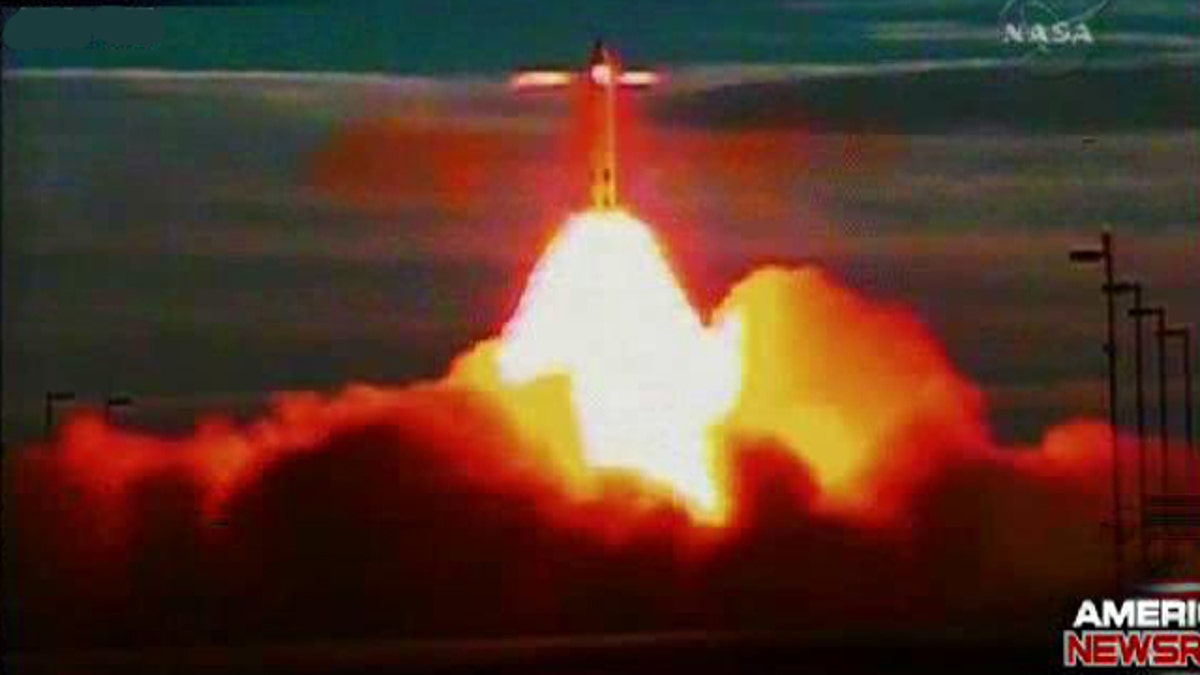
(NASA TV)
WHITE SANDS, New Mexico -- NASA launched a powerful emergency escape system for its new Orion spacecraft on a successful test flight Thursday, even as plans for the crew capsule are still being restructured.
Called Pad Abort-1, the $220 million Orion escape system test showcased the system that could be used to rescue a crew and its spacecraft in case of emergencies at the launch pad. The test was conducted here at the U.S. Army's White Sands Missile Range in New Mexico. Liftoff occurred on time at 9 a.m. EDT.
Orion is only one small element of the now-cancelled plans to replace the aged space shuttle program, a program called Constellation. NASA would have replaced the shuttle with a heavy lift rocket, called Ares, and the Orion capsule to transport crew members.
"Beautiful flight!" a test flight controller said after liftoff. This SPACE.com graphic shows how the escape system would work.
Roaring off into New Mexico skies, the Launch Abort System propelled a boilerplate Orion crew module to some 6,000 feet altitude on an arcing trajectory above the desert landscape.
After a rapid-fire sequence of events, including mid-air reorientation, drogue and main parachute deployments, the capsule landed about 6,919 feet – a bit farther than expected.
"Wow, that went like clockwork from what I can see," said Jay Estes, NASA's deputy manager of the Orion project office. "That's an amazing test."
The launch abort system is designed to activate within milliseconds in the event of an emergency on the launch pad or during initial ascent.
Safer space vehicles
NASA officials noted that, although Orion is a component of the agency's Constellation program that's now under both White House and Congressional scrutiny, today's test is part of the space agency's ongoing mission to develop safer space vehicles for all human spaceflight applications.
"The test is part of an ongoing mission at NASA to develop safer vehicles for human spaceflight applications," NASA spokesperson Kylie Clem told SPACE.com. "Data from the test will have wide applicability to future launch vehicles."
President Barack Obama said in an April 15 speech at NASA's Kennedy Space Center that he favors use of the Orion Crew Exploration Vehicle in a stripped-down version to serve as an astronaut lifeboat attached to the International Space Station.
Today's Pad Abort-1 test made use of three solid propellant rocket motors: an abort motor, an attitude control motor, and a jettison motor:
* The primary motor is the abort motor, which is used to propel the crew module away from the pad.
* The attitude control motor steers the vehicle to actively maintain stability and reorient it as needed.
* The jettison motor pulls the whole launch abort system away from the crew module and clears the way for parachute deployment and landing.
In addition to the motor stack, the launch abort system also included a fairing assembly that covered the boilerplate Orion crew vehicle and its nose cone.
The test flight was initiated by command from a specially built mobile operations facility – a large trailer acting as mission control. That command ignited both the Launch Abort System's abort and attitude control motors, pulling the crew module in an upward trajectory from the pad to a roughly mile-high altitude.
Government, industry team
An array of NASA centers and contractors were involved in today's Pad Abort-1 test.
The test module and launch abort system stack were built at NASA's Langley Research Center in Virginia. Systems installation and integration took place at NASA's Dryden Flight Research Center at Edwards Air Force Base in California.
NASA's Langley leads the development of the LAS in partnership with the space agency's Marshall Space Flight Center. Dryden is conducting the launch abort flight test effort for the Orion Project Office at the Johnson Space Center, Houston.
On the industrial side of the test, Lockheed Martin is the prime contractor to NASA for the Orion crew exploration vehicle. Orbital Sciences Corporation is responsible for the design, development, test and integration of the Launch Abort System for Lockheed Martin.
Alliant Techsystems, or ATK, developed the attitude control motor, which includes eight thrusters producing up to 7,000 pounds of thrust. ATK also developed the abort motor to pull the capsule away from the launch pad.
Aerojet developed the jettison motor, which is the only motor of the three that would be used in all flight cases to pull the escape tower from the crew module.
Copyright © 2010 Space.com. All rights reserved. This material may not be published, broadcast, rewritten or redistributed.
